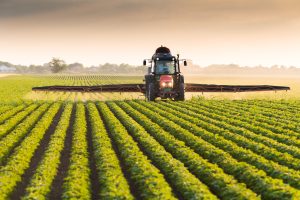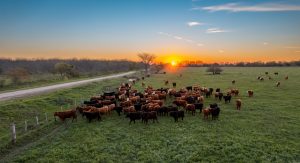Oklahoma Bar Journal
Oklahoma's Agricultural Law
By Brendon S. Atkinson

Dusan Kostic | #158448465 | stock.adobe.com
“There’s no such thing as agricultural law.” It has been 15 or 20 years ago now, but I can still hear those words as though they were spoken earlier today. “It’s contract law and torts, the same as anything else,” scoffed the attorney regarded by many, including myself, as the attorney for all things agriculture. It was a position I halfheartedly adopted as my own for some time thereafter. After all, as usual, he wasn’t wrong. The elements of liability for negligence are the same, regardless of whether the fact pattern involves a Corvette or a combine; a grain contract requires an offer, acceptance and consideration – just like a contract to sell a house or an employment agreement.
At this point, you may be asking, what about the Plant Variety Protection Act, the Packers and Stockyard Act, Chapter 12 of the Bankruptcy Code, etc. – aren’t those agricultural law? There is no question that each was developed and has evolved to deal with issues in agriculture. I would not begin to argue against those who choose to place those areas of law under the umbrella of “agricultural law.” However, you would be hard-pressed to find an Oklahoma farmer or rancher looking for legal services to patent a new plant species they’ve developed. I don’t know of any “family farmers” who want representation in search of relief under the Bankruptcy Code. I think our position that “agricultural law” didn’t exist was founded upon a mindset or belief that neither these nor any other special laws affected average, day-to-day agricultural operations. However, representing farmers, ranchers and agricultural entities in those 15 or 20 years since, I realized somewhere along the way that maybe we weren’t entirely correct.
As recent as 2015, Oklahoma was the third-largest producing state in the United States for winter wheat and the second-largest producing state for beef cattle.[1] During the same time period, 76% of Oklahoma’s land area was used for agricultural purposes, and one in every eight jobs in Oklahoma had a direct tie to agriculture.[2] With these statistics in mind, it should come as no surprise that over time, law has arisen that directly affects Oklahoma’s agricultural industry on a regular basis. In fact, these “agricultural laws” are not only not typical “contract law” or “tort law,” but in some cases, Oklahoma’s agricultural law alters the applicability of other areas of law to the state’s agricultural industry. Though not an exhaustive list, this article will discuss a few of Oklahoma’s agricultural laws that practitioners should keep in mind if they represent clients involved in and/or affected by agriculture in Oklahoma.
AGRICULTURAL ENTITIES
A good place to start this discussion is the agricultural law that dictates who can or, maybe more precisely, who cannot engage in farming and ranching in the state of Oklahoma. Over the last several years, entities, especially corporations and limited liability companies, have become popular tools in farming and ranching operations as a means to limit liability, transition management and ownership, etc. However, “corporate” farming has not always been permitted in Oklahoma. In fact, though rarely scrutinized, there are limitations on which entities may engage in farming and ranching in Oklahoma.
Article 22, §2 of the Oklahoma Constitution explicitly prohibits corporations from “buying, acquiring, trading, or dealing in” rural real estate. For a time, this prohibition was understood to also be a prohibition on farming and ranching by a corporate entity. However, in LeForce v. Bullard,[3] the Oklahoma Supreme Court stated, “The intention of the framers of the Constitution was not to prevent private corporations from owning land, but to prevent land companies from buying rural land and further to prevent private corporations from buying more rural land than necessary and proper for their operation, so as to encourage private rural home ownership.” The LeForce court went on to remind the Legislature that, should it desire, it had “ample” power to limit any potential abuses of corporate ownership of rural real estate. A few years later, in 1971, the Legislature did that by adding 18 O.S. §§951 through 954, and again in 1978 by adding 18 O.S. §§955 and 956.[4]
Section 951 declares the prohibition of foreign farming and ranching corporations to be the public policy of this state[5] and further establishes the requirements for domestic farming or ranching corporations. Likewise, §955 adds requirements for the engagement in farming or ranching by trustees of trusts, partnerships and limited liability companies and restates the requirements for corporations. Without going into the details for each entity structure, these provisions essentially restrict who may hold interests in the entity, limit how many interest holders each entity may have and the minimum percentage of gross receipts that must be derived by each entity from farming and ranching activities.
So who enforces these requirements? Section 951 states that certificates of incorporation are to be approved by the State Board of Agriculture prior to being filed with the secretary of state. Though the same requirement has been inferred for other entity structures, §955 does not specifically provide the requirement for pre-approval. Once upon a time, the organizational papers for an entity whose name even remotely suggested a connection to farming and ranching were required to bear the stamp of approval from the State Board of Agriculture before the secretary of state’s office would begin to process them. Today, I’m not sure that is still the case. Nevertheless, the Oklahoma Department of Agriculture, Food and Forestry (ODAFF) website does provide a link to an attestation form to be used in seeking the State Board of Agriculture’s approval.
Following formation, the State Board of Agriculture is directed to “initiate and prosecute civil or criminal actions to enforce the provisions of this code.” Again, this directive clearly applies to corporations, but its application to other entity structures is not as clear. That said, violation of the farming or ranching requirements for any entity carries the possibility of a $500 fine and the possibility of misdemeanor charges. Ultimately, though, it is the citizens of this state who have been empowered to oversee the use of legal entities for farming and ranching.
Both farming and ranching require the use of real estate, and Oklahoma uses a lot of real estate for those purposes. Assuming then that a farming or ranching entity requires real estate to operate, it is only logical that §956 was included to ensure compliance with the entity requirements. If an entity is in violation of the requirements of §956 and owns real estate, any resident of the county in which that real estate is held may file a district court action for the divestment of the real estate. With this in mind, if the decision is made to utilize entities in farming and ranching operations, those entities should be reviewed on a regular basis to ensure continued compliance with the farming and ranching entity requirements. Otherwise, this agricultural law could make continued operations a little difficult.

fernando | #511537899 | stock.adobe.com
DAMAGES FROM PESTICIDE APPLICATIONS
A common agricultural practice is the application of pesticides to crops and growing plants in order to protect them from insects, weeds and numerous other pests. The application of pesticides[6] in Oklahoma is governed by the Combined Pesticide Law (CPL), which is found under the Agricultural Code at 2 O.S. §3-81 et al. and is regulated and enforced by ODAFF through its Consumer Protection Services Division. The CPL sets forth several requirements that must be met for persons and entities to become certified applicators of pesticides in this state and the criteria by which the applicators and their applications of pesticides will be reviewed. In addition to the requirements imposed on the pesticide applicators, the Legislature also included requirements in the CPL that must be met by those who claim to have been damaged by pesticide applicators. Specifically, the CPL provides at 2 O.S. §3-82(D)[7] that:
DAMAGES – 1. Prior to filing an action against an applicator for damages to growing crops or plants, any person alleging damages to growing crops or plants shall:
-
- within ninety (90) calendar days of the date that the alleged damages occurred or prior to the time that twenty-five percent (25%) of the allegedly damaged crops or plants are harvested, whichever occurs first, file a written complaint statement with the Department regarding the alleged damages, and
- between the date of filing of the written complaint pursuant to subparagraph a of this paragraph and the date harvesting or destruction of the allegedly damaged crops or plants occurs, allow the applicator and the representatives of the applicator reasonable access to the property to inspect and take samples of the allegedly damaged crops or plants during reasonable hours. The representatives of the applicator may include, but not be limited to, crop consultants, bondsmen, and insurers. Nothing in this subparagraph shall limit in any way the harvesting or destruction of the allegedly damaged crops or plants in the ordinary course of business and practice.
- Any person failing to comply with paragraph 1 of this subsection shall be barred from filing an action for damages against the applicator.
Probably the best explanation of the purpose and effect of this statute was given by the Oklahoma Supreme Court in Olmstead v. Reedy.[8] Olmstead was a case involving alleged damages to plants and crops as a result of pesticides drifting onto the plaintiff’s property after having been applied to an adjoining property. In that case, the Oklahoma Supreme Court stated, “The language of the statute (2 O.S. 3-82) seems clearly to provide that the filing of the written statement of damages is a condition precedent to the right to commence the action.”[9] “The statute appears to us not to have been intended to terminate or limit the rights of one whose property is damaged by an applicator of pesticides but to prevent undue delay in reporting any alleged damages.”[10] “Another purpose of the statutory requirement apparently was to afford defendants an opportunity to investigate the circumstances while the claimed damages were fresh and prior to change and to preserve evidence for their defense.”
Pesticide damage claims come in many forms. They result from both direct applications of pesticides and drift, i.e., movement of pesticides from their intended targets. As you might imagine, causes of action in these matters range from breach of contract and simple negligence to trespassing and everything in between. However, 2 O.S. §3-82(H) does not differentiate between types of claims or causes of action. Instead, it unequivocally provides that the “failure to file a written statement of damages pursuant to the statute is certainly fatal to a plaintiff's lawsuit.”[11]
Should you ever find yourself with a client who believes that their crops or growing plants were damaged by pesticides, you should determine if a written complaint statement has been filed with ODAFF, and if it hasn’t, one must be filed immediately. Fortunately, ODAFF provides two online sources for accomplishing this. By visiting ag.ok.gov/pesticides, an online statement can be submitted directly to ODAFF, or a pesticide complaint statement can be downloaded with directions for filling out and filing with ODAFF. On the other hand, in defense of an applicator, a request to ODAFF under the Open Records Act[12] will reveal whether the §3-82(H) defense is available, as well as the results, if any, of any investigations performed by ODAFF in response to a written complaint statement.
RESTRAINT OF DOMESTIC ANIMALS
I’m sure we all have that one thing that, “If I had a nickel for every time that I’ve heard [fill in the blank], I’d be rich.” For me, it would be that “Oklahoma is an open-range state.” Well, it’s not and hasn’t been since “Grazing in Open Range Counties” was repealed in 1966. What I think those well-intentioned but uninformed souls are referring to is the perceived lack of liability for damage that may result from the escape of their animals from their fencing or other restraints. That, however, is not entirely correct either.
One of the best examples of the effect of Oklahoma’s agricultural law on other areas of the law may be the duties and requirements associated with the restraint of “domestic animals.”[13] Not only is Oklahoma not an “open range state,” but 4 O.S. §98 requires that “all domestic animals shall be restrained by the owner thereof at all times and seasons of the year from running at large in the State of Oklahoma.” When those domestic animals escape restraint, though, that’s when things get interesting.
Anyone who has been involved with animal husbandry for any length of time knows that some, if not most, animals seem to think the grass is always greener on the other side of the fence. No matter the amount of sustenance and comfort provided, they seem to think better pastures exist. The duty of care required in ensuring the restraint of those animals is determined by the damage resulting from their escape.
In Shuck v. Cook,[14] the Oklahoma Supreme Court held that it was the intent of the Legislature for 4 O.S. §98 to protect growing crops, not persons traveling by automobile down the highway. With Carver v. Ford,[15] the court acknowledged the strict liability effect of §98 for damages to crops and grazing lands by an escaped animal but stated clearly that in order to recover for any other type of damage, it must be shown that the animal was either intentionally or negligently allowed to “run loose.” The result: If farmer A's bull decides to go in search of greener pastures, they are strictly liable to farmer B for all of farmer B’s corn that is destroyed by the trespassing bull. But if that same bull then proceeds to cross the highway where it is struck by a traveler, in order to recover from farmer A, the traveler must show that the bull’s escape was a result of an intentional act by farmer A or that the bull escaped restraint due to farmer A’s negligence – same agricultural law, two completely different proceedings.
CONCLUSION
Most Oklahoma attorneys would not consider agricultural law to be a part of their practice. If you are ever presented with a matter involving farming or ranching in any way, I would suggest exploring it. It is just contract law and torts, the same as anything else, unless Oklahoma agricultural law says it isn’t.
 ABOUT THE AUTHOR
ABOUT THE AUTHOR
Brendon S. Atkinson is a solo practitioner with The Atkinson Law Firm PLLC in Enid. He has been representing farmers, ranchers and agricultural entities in the region for more than 20 years. Prior to entering private practice, he was a staff counsel for the Oklahoma Department of Agriculture, Food and Forestry. A native of Sweetwater, Oklahoma, Mr. Atkinson obtained his J.D. from the OU College of Law and his B.S. in agricultural economics from OSU.
ENDNOTES
[1] Department of Agricultural Economics Division of Agricultural Sciences and Natural Resources Oklahoma State University: (2015) Contribution of Agriculture to Oklahoma’s Economy [Fact Sheet]. https://bit.ly/3TR6uUs.
[2] See endnote 1.
[3] 1969 OK 14, 454 P.2d 297.
[4] 18 O.S. §954 was enacted in 2000 to add an exemption for Production of Nursery Stock.
[5] Exemptions to this prohibition are provided in both 18 O.S. §§954 and 954.1.
[6] As used in the CPL, “pesticide” means a substance or mixture of substances intended for defoliating or desiccating plants, preventing fruitdrop, inhibiting sprouting or for preventing, destroying, repelling or mitigating any insects, rodents, fungi, bacteria, weeds or other forms of plant or animal life or viruses that the Board of Agriculture declares to be a pest, except viruses on or in humans or animals. 2 O.S. §3-81(34).
[7] On Nov. 1, 2023, 2 O.S. §3-82(H) was recodified as 2 O.S. §3-82(D).
[8] 1963 OK 268, 387 P.2d 631.
[9] Id.
[10] Id.
[11] Brown v. Rocky Farmers Co-op, Inc., 2005 OK CIV APP 52, 118 P.3d 214; citing McArdle v. Stewart, 1968 OK 153, 446 P.2d 379.
[12] 51 2 O.S. §24A.1, et seq.
[13] 4 O.S. §98 defines “domestic animals” as including “cattle, horses, swine, sheep, goats, exotic livestock and all other animals not considered wild” but does not include domestic house pets.
[14] 1972 OK 25, 494 P. 2d 306.
[15] 1979 OK 26, 591 P. 2d 305.
Originally published in the Oklahoma Bar Journal – OBJ 95 No. 2 (February 2024)
Statements or opinions expressed in the Oklahoma Bar Journal are those of the authors and do not necessarily reflect those of the Oklahoma Bar Association, its officers, Board of Governors, Board of Editors or staff.
